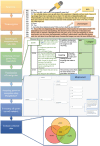Secondary amputation: a qualitative study of quality of life in patients after primary limb salvage surgery and after later ablative sarcoma treatment
- PMID: 39873158
- PMCID: PMC11795125
- DOI: 10.2340/jrm.v57.34888
Secondary amputation: a qualitative study of quality of life in patients after primary limb salvage surgery and after later ablative sarcoma treatment
Abstract
Objective: This study focuses on how patients experience the time following amputation after primary limb salvage surgery due to musculoskeletal malignancies. Limb salvage is state of the art in the treatment of musculoskeletal tumours. Nonetheless, in some cases, limb salvage can become problematic over time, resulting in poorer limb function and septic outcomes. This raises the question of whether amputation is indicated sooner rather than later. Patients who have undergone secondary amputation might retrospectively prefer a different approach.
Design: Interview study.
Subjects/patients: Patients who underwent primary limb salvage surgery followed by later ablative sarcoma treatment.
Methods: Semi-structured interviews and the standardized "Prosthetic Limb Users Survey of Mobility" questionnaire were conducted. Interviews were analysed according to Mayring content analysis method.
Results: Amputation is perceived as an improvement after a long course of illness with little quality of life. By enhancing the amputation environment and providing detailed information regarding quality of life afterwards, emotional pressure could be reduced and patient satisfaction improved.
Conclusion: Surgical options for ablation should be openly communicated earlier when consulting patients experiencing recurrent complications that might eventually lead to amputation. Supporting factors that subsequently may help to improve quality of life after amputation were further identified.
Figures




Similar articles
-
[Amputation or limb salvage? Assessing quality of life after tumor operations of the lower extremity].Orthopade. 2003 Nov;32(11):1020-7. doi: 10.1007/s00132-003-0548-5. Orthopade. 2003. PMID: 14615852 German.
-
Decision-making in Orthopaedic Oncology: Does Cognitive Bias Affect a Virtual Patient's Choice Between Limb Salvage and Amputation?Clin Orthop Relat Res. 2020 Mar;478(3):506-514. doi: 10.1097/CORR.0000000000000674. Clin Orthop Relat Res. 2020. PMID: 31173578 Free PMC article.
-
Psychosocial and functional outcomes in long-term survivors of osteosarcoma: a comparison of limb-salvage surgery and amputation.Pediatr Blood Cancer. 2010 Jul 1;54(7):990-9. doi: 10.1002/pbc.22419. Pediatr Blood Cancer. 2010. PMID: 20135700 Free PMC article.
-
[Long-term functional results after sarcoma resection].Chirurg. 2014 Mar;85(3):215-20, 222-3. doi: 10.1007/s00104-013-2603-z. Chirurg. 2014. PMID: 24595478 Review. German.
-
Criteria and outcome of limb salvage surgery.J BUON. 2011 Oct-Dec;16(4):617-26. J BUON. 2011. PMID: 22331712 Review.
References
-
- Casali PG, Abecassis N, Aro HT, Bauer S, Biagini R, Bielack S, et al. . Soft tissue and visceral sarcomas: ESMO-EURACAN Clinical Practice Guidelines for diagnosis, treatment and follow-up. Ann Oncol 2018; 29: iv51–iv67. - PubMed
MeSH terms
LinkOut - more resources
Full Text Sources
Medical

